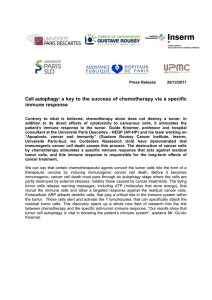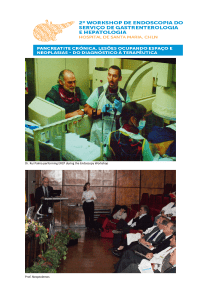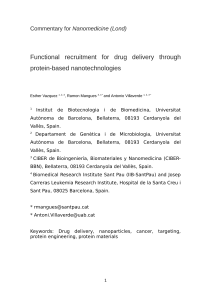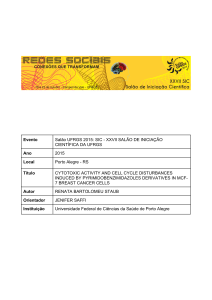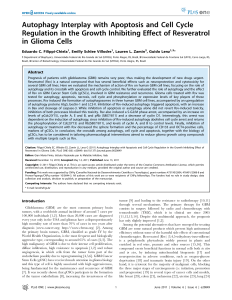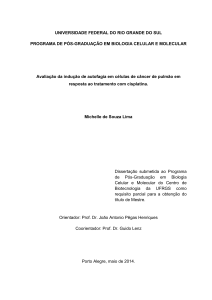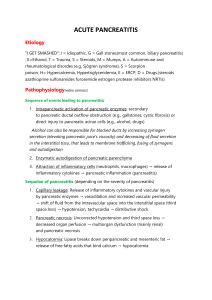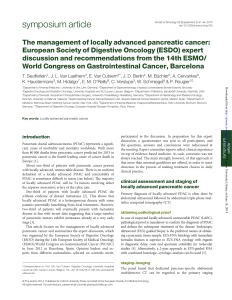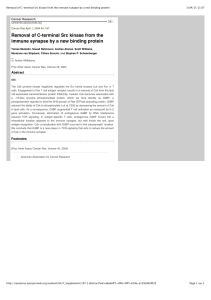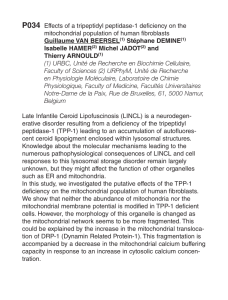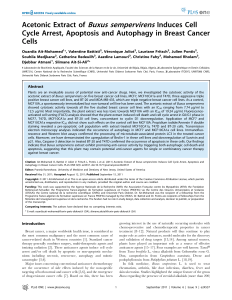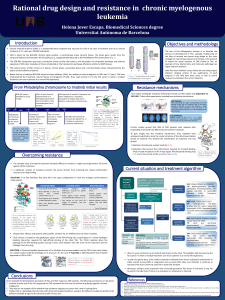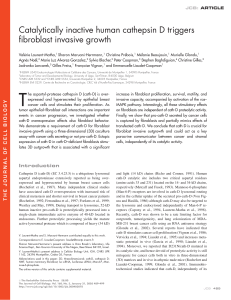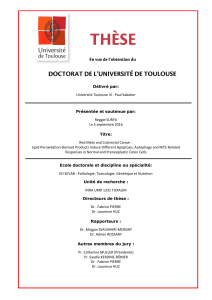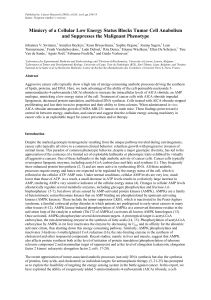TFG guillempratsejarque
publicité
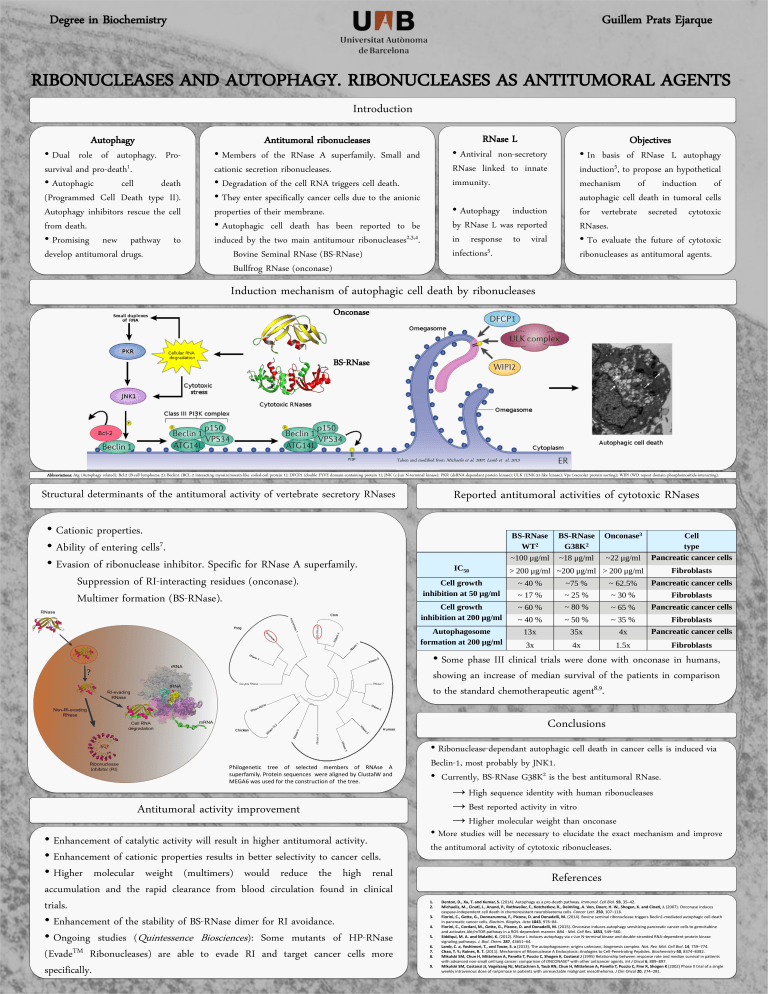
Degree in Biochemistry Guillem Prats Ejarque RIBONUCLEASES AND AUTOPHAGY. RIBONUCLEASES AS ANTITUMORAL AGENTS Introduction Autophagy • Dual role of autophagy. Prosurvival and pro-death1. • Autophagic cell death (Programmed Cell Death type II). Autophagy inhibitors rescue the cell from death. • Promising new pathway to develop antitumoral drugs. RNase L Antitumoral ribonucleases Objectives • Antiviral non-secretory RNase linked to innate immunity. • Members of the RNase A superfamily. Small and cationic secretion ribonucleases. • Degradation of the cell RNA triggers cell death. • They enter specifically cancer cells due to the anionic properties of their membrane. • Autophagic cell death has been reported to be induced by the two main antitumour ribonucleases2,3,4. Bovine Seminal RNase (BS-RNase) Bullfrog RNase (onconase) • In basis of RNase L autophagy induction5, to propose an hypothetical mechanism of induction of autophagic cell death in tumoral cells for vertebrate secreted cytotoxic RNases. • To evaluate the future of cytotoxic ribonucleases as antitumoral agents. • Autophagy induction by RNase L was reported in response to viral infections5. Induction mechanism of autophagic cell death by ribonucleases Onconase BS-RNase Taken and modified from Michaelis et al, 2007; Lamb et al, 2013 Abbreviations: Atg (Autophagy related); Bcl-2 (B-cell lymphoma 2); Beclin1 (BCL-2 interacting myosin/moesin-like coiled-coil protein 1); DFCP1 (double FYVE domain-containing protein 1); JNK (c-Jun N-terminal kinase); PKR (dsRNA-dependant protein kinase); ULK (UNK-51-like kinase); Vps (vacuolar protein sorting); WIPI (WD repeat domain phosphoinositide-interacting). Reported antitumoral activities of cytotoxic RNases Structural determinants of the antitumoral activity of vertebrate secretory RNases • Cationic properties. • Ability of entering cells7. • Evasion of ribonuclease inhibitor. Specific for RNase A superfamily. Suppression of RI-interacting residues (onconase). Multimer formation (BS-RNase). BS-RNase WT2 ~100 μg/ml IC50 BS-RNase G38K2 ~18 μg/ml Onconase3 ~22 μg/ml > 200 μg/ml ~200 μg/ml > 200 μg/ml Cell type Pancreatic cancer cells Fibroblasts Cell growth inhibition at 50 μg/ml ~ 40 % ~75 % ~ 62.5% Pancreatic cancer cells ~ 17 % ~ 25 % ~ 30 % Fibroblasts Cell growth inhibition at 200 μg/ml ~ 60 % ~ 80 % ~ 65 % Pancreatic cancer cells ~ 40 % ~ 50 % ~ 35 % Fibroblasts Autophagosome formation at 200 μg/ml 13x 35x 4x Pancreatic cancer cells 3x 4x 1.5x Fibroblasts • Some phase III clinical trials were done with onconase in humans, showing an increase of median survival of the patients in comparison 8,9 to the standard chemotherapeutic agent . ? Conclusions Philogenetic tree of selected members of RNAse A superfamily. Protein sequences were aligned by ClustalW and MEGA6 was used for the construction of the tree. Antitumoral activity improvement • Enhancement of catalytic activity will result in higher antitumoral activity. • Enhancement of cationic properties results in better selectivity to cancer cells. • Higher molecular weight (multimers) would reduce the high renal accumulation and the rapid clearance from blood circulation found in clinical trials. • Enhancement of the stability of BS-RNase dimer for RI avoidance. • Ongoing studies (Quintessence Biosciences): Some mutants of HP-RNase TM (Evade Ribonucleases) are able to evade RI and target cancer cells more specifically. • Ribonuclease-dependant autophagic cell death in cancer cells is induced via Beclin-1, most probably by JNK1. • Currently, BS-RNase G38K2 is the best antitumoral RNase. → High sequence identity with human ribonucleases → Best reported activity in vitro → Higher molecular weight than onconase • More studies will be necessary to elucidate the exact mechanism and improve the antitumoral activity of cytotoxic ribonucleases. References 1. 2. 3. 4. 5. 6. 7. 8. 9. Denton, D., Xu, T. and Kumar, S. (2014). Autophagy as a pro-death pathway. Immunol. Cell Biol. 93, 35–42. Michaelis, M., Cinatl, J., Anand, P., Rothweiler, F., Kotchetkov, R., Deimling, A. Von, Doerr, H. W., Shogen, K. and Cinatl, J. (2007). Onconase induces caspase-independent cell death in chemoresistant neuroblastoma cells. Cancer Lett. 250, 107–116. Fiorini, C., Gotte, G., Donnarumma, F., Picone, D. and Donadelli, M. (2014). Bovine seminal ribonuclease triggers Beclin1-mediated autophagic cell death in pancreatic cancer cells. Biochim. Biophys. Acta 1843, 976–84. Fiorini, C., Cordani, M., Gotte, G., Picone, D. and Donadelli, M. (2015). Onconase induces autophagy sensitizing pancreatic cancer cells to gemcitabine and activates Akt/mTOR pathway in a ROS-dependent manner. BBA - Mol. Cell Res. 1853, 549–560. Siddiqui, M. A. and Malathi, K. (2012). RNase L induces autophagy via c-Jun N-terminal kinase and double-stranded RNA-dependent protein kinase signaling pathways. J. Biol. Chem. 287, 43651–64. Lamb, C. a, Yoshimori, T., and Tooze, S. a (2013). The autophagosome: origins unknown, biogenesis complex. Nat. Rev. Mol. Cell Biol. 14, 759–774. Chao, T. Y.; Raines, R. T. (2011). Mechanism of Ribonuclease A Endocytosis: Analogies to Cell-Penetrating Peptides. Biochemistry 50, 8374–8382. Mikulski SM, Chun H, Mittelman A, Panella T, Puccio C, Shogen K, Costanzi J (1995) Relationship between response rate and median survival in patients with advanced non-small cell lung cancer: comparison of ONCONASE® with other anticancer agents. Int J Oncol 6, 889–897. Mikulski SM, Costanzi JJ, Vogelzang NJ, McCachren S, Taub RN, Chun H, Mittelman A, Panella T, Puccio C, Fine R, Shogen K (2002) Phase II trial of a single weekly intravenous dose of ranpirnase in patients with unresectable malignant mesothelioma. J Clin Oncol 20, 274–281.
